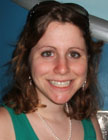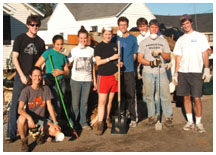|
Web Exclusives: PawPlus
December 14, 2005: Gulf
Coast journal During fall break, 20 undergraduates from the Student Volunteers Council traveled to sites in Louisiana and Alabama to assist residents and clean up the damage left by hurricanes Katrina and Rita. Stephanie Feldstein ’08 of San Diego, one of 10 students volunteering in Abbeville, La., kept a journal of her experiences for PAW (a condensed version was published in PAW’s Dec. 14 issue). Sunday, Oct. 30 Flight 225 from Newark to Baton Rouge was ready to land. Half dozing, I watched the tray-tables being returned to their upright positions, the seatbelt sign blinking, and the flight attendants scurrying about the cabin. Excited and nervous about our trip, I stared out the small airplane window, trying to imagine what I would see once we touched down. For weeks my mind had been in overdrive, processing all the images of hurricane destruction: houses torn apart by wind and water, animals drowning in floods, stranded people in desperate need of help and supplies. Walking through the airport, I imagined myself entering a war zone. I wonder if my fellow soldiers shared my surprise as we stepped outside and saw that the world looked … well, normal. People drank coffee and laughed while the sun shone brightly overhead – where was the apocalyptic scene I had envisioned? After driving 45 minutes to Abbeville, we stopped by the local Baptist church to meet some of the people we would be helping this week. Still recovering from my first Southern meal (a fiesta del fried: not one alligator, shrimp, crab leg, or mushroom had been spared the deep fryer), I listened to the congregation’s enthusiastic worship, played with the pastor’s daughter, and was overwhelmed by our positive reception. Everyone was glad we were there, even people whom we wouldn’t be directly helping. We went to sleep that night full, happy, and ready to work. Monday, Oct. 31 The town of Erath, a few minutes from Abbeville, had opened its arms to the victims of Hurricane Katrina, providing them with food and shelter after the disaster. Just weeks later, Hurricane Rita hit them hard, and though no lives were lost, a quick drive to our site showed the physical damage it had done. As we turned a corner I could almost imagine a normal Southern street, lined with houses; a second look revealed, however, that the houses were no more than empty shells, their flood-damaged contents piled on the curb. The foundations were there, but little else survived. Yellow “X”s had been scribbled on their front doors to show that they had been checked for survivors. We soon met Melba and Charles Tibideaux, an elderly Cajun couple who had lived in their home for 38 years and raised 11 foster children in it. They loved their house and wanted it saved, and we wanted to save it. Wearing masks to protect us from the pervasive smell (and spores) of mold and mildew, some of the boys helped remove their furniture while the rest of us took out the floors. With only a few shovels and a crowbar for tools, it was tough manual labor. Perhaps a little too eager to help, we shoveled until our hands were covered with blisters and our arms had progressed to a near-arthritic state. By the end of the day, we were tired and sore, but the floors were almost gone. Tuesday, Nov. 1 Munching on some Red-Cross provided snacks, I listened as Melba told me stories about picking cotton on her father’s farm as a child, about her daughter’s beauty pageants and her little grandaughters’ report cards (straight As, incidentally). Soon the conversation turned to the hurricane. “I had so many photos on the wall, all ruined,” she said. “My daughter’s wedding dress, her wedding photos, all gone. Our house is all we have left, and we don’t even have the money to rebuild it. FEMA said they would give us a trailer, but it hasn’t come yet. Maybe in a year – maybe two. Either way, a trailer isn’t home.” I knew this story had been told hundreds of times already, but sitting on the porch, listening to the 80-year-old woman relate it in her melodic Cajun accent, I began to understand. We could rebuild and we could restore, but we could never recover the little pieces of people’s lives that were lost. Some things were gone forever. It was up to us to do the best we could with what was left, and hope that eventually, new pieces would come to replace those that had been washed away. Wednesday, Nov. 2 We had to wear masks just stepping out of the car. I almost gagged as the smell of our next house, the stench of mold and decay, wafted toward us. Inside, there was still toast in the toaster and dirty dishes in the sink – the 84-year-old owner had left in a hurry. Our job was to get the floors out and to separate the items ruined by mold from those still salvageable. Unfortunately, this lady was an amazing packrat, and along with sorting through the normal pots, pans, and food, I found myself examining butter containers, soda-can tops, and gallons of water stored everywhere – under the bed, in the living room, even in the bathroom. In one room of the house, the windows had been closed since the hurricane, and without any ventilation, it had reached a new level in olfactory offense. There was still water on the floor, and we had to hold our breath in order to move the moldy books, chairs, clothes, and sofas to the curb. In addition, there were many items stored in cardboard boxes on the floor that were just soaked through. Peering inside one box, I saw it held the family photo albums. Wedding pictures, baby pictures, and honeymoon pictures were made unrecognizable by the water and colored mold that had infested them. I almost cried as I looked through the impressionistic mess, trying to make out a face or a person. We kept them all, of course. It’s what I would have wanted. Thursday, Nov. 3 We drove to Pecan Island, about 20 minutes south of Abbeville, a town that had been utterly devastated by Rita. For 15 minutes straight we saw the same strange sites: houses moved 30 yards from their risers, roofs on top of trees, tractors overturned, and front steps with the house nowhere to be seen. Two houses had smashed right into each other; enormous trees had fallen and crushed the earth below. Next to most risers we saw just piles of rubble. The entire island was dead. There was nothing we could do to help – there was nothing left to rebuild. Friday, Nov. 4 The mud was almost to my knees. Today I found myself in a flooded tool shed, looking for the hand-made Christmas ornaments that had extreme sentimental value to the owner. Shoveling mud out the door, I saw something blue. It was an ornament. There were seven more, and only one was broken. I smiled. The local senior center, our next site, was also filled with mud, and we spent most of the day throwing away furniture, TVs, and bingo cards encased in mud and mold. Sometimes I would open a box still full of water, and the smell would make me gag. This was hard, dirty work, but we were proud of what we were doing for the community. At the end of the day, Elbert, our boss from Vermilion Faith Community of Care, helped us clean the floors with a hose and mop. I wondered why we were cleaning, since the floors had to be taken out anyway. “So people aren’t afraid to come in here anymore,” Elbert told me. “They can look and see it fairly clean and think, ‘Maybe things aren’t so bad after all.’ ” Saturday, Nov. 5 After saying our goodbyes to everyone we worked with, we were
back on the plane, headed for Princeton. No one wanted to leave.
There was so much left to be done, so many people in need. I had
seen houses destroyed, lives changed, mementos forever gone –
but more importantly, I had seen triumph. I suppose adversity brings
out the best in us, but the cooperation and hard work I witnessed
was utterly amazing. No one was afraid of getting dirty; everyone
wanted to do everything they could to help those who needed it.
We may not have rebuilt Louisiana during fall break, but we had
some impact on the lives of the people we were able to assist.
|
||


